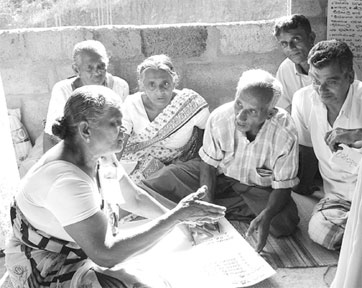|

World Health Day 2012 - April 7 :
Good health for a full life
By Nilma DOLE
Every year, the world commemorates World Health Day. The UN has
declared World Health Day with a message for people to think about their
health and maintain good health.
 The topic of World Health Day in 2012 is Ageing and Health that
revolves under the theme, 'Good health adds life to years'. The focus is
on how good health throughout life can help older people lead full and
productive lives and be a resource for their families and communities. The topic of World Health Day in 2012 is Ageing and Health that
revolves under the theme, 'Good health adds life to years'. The focus is
on how good health throughout life can help older people lead full and
productive lives and be a resource for their families and communities.
Ageing is a big topic which is now making us wonder if we are ready
to live longer.
Sri Lanka's life expectancy has grown tenfold and now we are
reporting a growing ageing population supported by good health, better
retirement schemes and the family structure.
Key indicators determine that with several help measures for senior
citizens, a better quality of life and changing trends where the focus
on keeping fit and healthy contributes not only to living longer years
but a better quality.
Part of the reason is the fact that we have efficient health services
and the high literacy and education of women. In addition to this, we
have good organisations that help older people and NGOs ensure that old
people and elder's homes are maintained.
The Institute of Policy Studies states that last year, Sri Lankans in
the 60 plus population amounted to 12 percent of our total population
and it is estimated to grow to 29 per cent by 2050.
According to the United Nations, Department of Economic and Social
Affairs, Population Division, Sri Lanka's fertility rates have dropped
from 2.1 percent in 1994 but life expectancy has increased with men
living up to 69 years and women living more than men at 77.
However, while having all the advantages; the Sri Lankan scenario is
such that we still have a long way to go.
We have nearly won the battle against illnesses that can be easily
vaccinated and immunised.
Moreover, diseases such as smallpox and diphtheria have been
virtually eliminated.
While we are ahead of our counterparts when it comes to achieving
MDGs (Millennium Development Goals), we still need to address key issues
especially with the changing trends of food habits, lifestyle changes
and our interaction with the environment when it comes to leading an
active lifestyle.
Key indicators emphasise that while we shift from communicable
diseases, we are heading towards a shift that it primarily revolved
around non-communicable diseases. Moreover, pollution, climatic changes
and chemicals in our food have seen a new wave of conditions such as
diabetes, heart disease and cancer.
And these reasons could hamper the road to ageing gracefully without
any problems or being a burden to family units. While we still have
unhealthy Sri Lankans, we are now ready to tackle such diseases with the
proper treatment, technology and preventive measures.
The ageing population ensures that our population ratio is balanced
and this means that we are having older people in employment, newer
forms of recruitment such as consultancy and a variety of investment and
fixed deposit schemes to live on.
In the 21st century, health is governed and assessed by certain
social trends and the penetration of this.
Economies are globalising with several people migrating and more are
moving to the cities for more work and better quality of life. What is
seen in Sri Lanka today is that family patterns are changing and
technology is evolving quickly.
A massive social transformation of our world population is ageing. It
is a likely predicament that the world will have older people than
children and more people of very old age than ever before.
According to the WHO, the world will have more people who live to see
their 80s or 90s with the number of people aged 80 years or older, for
example, will have almost quadrupled to 395 million between the year
2000 and 2050.
Reports also indicate that on average, women live six to eight years
longer than men.
Remarkable improvements in life expectancy have seen several nations
marking significant gains in age which has tremendous impact on
populations especially with better retirement schemes and contract
employment after retirement.
WHO also estimates that in the next five years, for the first time in
human history, the number of adults aged 65 and over will outnumber
children under the age of five.
By 2050, these older adults will outnumber children under 14. It also
states that between 2000 and 2050, the proportion of the world's
population over 60 years will double from about 11 percent to 22
percent.
The absolute number of people aged 60 years and over is expected to
increase from 605 million to 2 billion over the same period.
Sri Lanka's population will need to start now to have a healthy
lifestyle to maintain health and fitness much later on in life.
We need to ensure that healthy practices are inculcated into family
unit which means that while the parents are away working to earn an
income, grandparents are closer to their grandchildren and need to
instil good healthy habits.
This means that a healthy lifestyle culture should be in place to
help in giving the elderly population a better quality of life, not
being a burden to their families and forging closer ties to their
extended family unit.
However, we shouldn't forget the elder's homes where a significant
proportion of old people are kept by children who are abroad or for
other reasons. Whether it is right or wrong, there are social systems
and helping mechanisms to help the senior citizens of Sri Lanka.
How tearjerkers make people happier
People enjoy watching tragedy movies like "Titanic" because they
deliver what may seem to be an unlikely benefit: tragedies actually make
people happier in the short-term.
 |
|
Tragedies have positive
aspects |
Researchers found that watching a tragedy movie caused people to
think about their own close relationships, which in turn boosted their
life happiness.
The result was that what seems like a negative experience - watching
a sad story - made people happier by bringing attention to some positive
aspects in their own lives.
"Tragic stories often focus on themes of eternal love, and this leads
viewers to think about their loved ones and count their blessings," said
Silvia Knobloch-Westerwick, lead author of the study.
The key is the extent to which viewers thought about their own
relationships as a result of watching the movie.
The more they thought about their loved ones, the greater the
increase in their happiness.
Viewers who had self-centered thoughts concerning the movie - such as
"My life isn't as bad as the characters in this movie" - did not see an
increase in their happiness.
Knobloch-Westerwick said this study is one of the first to take a
scientific approach to explaining why people enjoy fictional tragedies
that make them sad.
"Philosophers have considered this question over the millennia, but
there hasn't been much scientific attention to the question," she said.
Knobloch-Westerwick conducted the study with Yuan Gong, a graduate
student, and Holly Hagner and Laura Kerkeybian, both undergraduates, all
at Ohio State.
The results appear online in the journal Communication Research and
will appear in an upcoming print edition.
The study involved 361 college students who viewed an abridged
version of the 2007 movie Atonement, which involves two lovers who are
separated and die as war casualties.
Before and after viewing the movie, the respondents were asked
several questions which measured how happy they were with their life.
They were also asked before, after and three times during the movie to
rate how much they were feeling various emotions, including
sadness.After the movie, participants rated how much they enjoyed the
movie and wrote about how the movie had led them to reflect on
themselves, their goals, their relationships and life in general.
What people wrote about as a result of seeing the movie was a key in
understanding why people enjoy viewing fictional tragedies,
Knobloch-Westerwick said.
People who experienced a greater increase in sadness while watching
the movie were more likely to write about real people with whom they had
close relationships, she said.
This in turn, increased participants' life happiness after viewing,
which was then related to more enjoyment of the movie. "People seem to
use tragedies as a way to reflect on the important relationships in
their own life, to count their blessings," she said.
"That can help explain why tragedies are so popular with audiences,
despite the sadness they induce."The researchers also tested the theory
that people may feel more happiness after viewing a tragedy movie
because they compare themselves to the characters portrayed and feel
good that their own lives are not as bad. But that wasn't the case.
People whose thoughts after the movie were about themselves - rather
than about their close relationships - did not experience an increase in
life happiness.
"Tragedies don't boost life happiness by making viewers think more
about themselves.
They appeal to people because they help them to appreciate their own
relationships more," she said.
But why would people have to get sad by watching a tragedy to feel
grateful about relationships in their own lives? Knobloch-Westerwick
said this fits with research in psychology that suggests negative moods
make people more thoughtful.
"Positive emotions are generally a signal that everything is fine,
you don't have to worry, you don't have to think about issues in your
life," she said.
"But negative emotions, like sadness, make you think more critically
about your situation. So seeing a tragic movie about star crossed lovers
may make you sad, but that will cause you to think more about your own
close relationships and appreciate them more."
Research has also shown that relationships are generally the major
source of happiness in our lives, so it is no surprise that thinking
about your loved ones would make you happier, she said. "Tragedies bring
to mind close relationships, which makes us happy.
- esciencenews
Saving children's lives through Malaria prevention
Malaria continues to be a major disease worldwide, but while funding
projects are working hard to improve malaria prevention it is difficult
to measure how effective these interventions are.
New research published in BioMed Central's open access Malaria
Journal has used a Lives Saved Tool (LiST) model to show that the
increase in funding for the prevention of malaria has prevented 850,000
child deaths in the decade between 2001 and 2010 across Africa.
According to the WHO, malaria caused an estimated 655,000 deaths in
2010, mostly among African children. They estimate that a child dies
every minute due to malaria in Africa. Deaths which are unnecessary,
because malaria is both preventable and curable. In addition to
diagnosis and treatment of sick children, simple solutions to prevent
the diseases like insecticide treated mosquito nets (ITN) and malaria
prevention during pregnancy, (IPTp), have all been shown to reduce the
number of deaths due to malaria.
Initiatives such as Roll Back Malaria, set up in 1998, aim of
reducing child mortality due to malaria by two-thirds, by 2015, using
large scale implementation of these simple solutions.
Researchers investigated the impact of Malaria prevention in the
decade between 2001 and 2010 across 43 countries in sub Saharan Africa
where malaria is endemic. A team, led by Dr Thomas Eisele, based their
model on UN estimates of malaria deaths over the year 2000 and future
population growth, the effectiveness of ITNs and IPTp in preventing
child deaths, and the number of households using ITN to protect their
children.
Malaria prevention has been estimated to have saved 850,000
children's lives over the past decade. 99% of these were saved by using
ITN alone. Dr Thomas Eisele said, "Malaria continues to cause a
tremendous amount of child deaths throughout Africa. If 100% of the
children at risk of malaria had insecticide mosquito nets we estimate as
many as 2.77 million additional children's lives could be saved by
2015."
These figures are believed to be the lower estimate of deaths
prevented by anti-malaria initiatives since they do not include the
impact of better access to treatment with anti-malarials.
However, the threat of malaria remains and both prevention and
treatment plans need to be sustained for these improvements to be
maintained.
- pleasanthealthcare
Hepatitis E rife in Asia and Africa
New research funded by the World Health Organisation (WHO) estimates
that 20.1 million individuals were infected with hepatitis E virus (HEV)
genotypes 1 and 2 across 9 world regions in 2005. According to findings
available in the April issue of Hepatology, a journal published by
Wiley-Blackwell on behalf of the American Association for the Study of
Liver Diseases, there were 3.4 million symptomatic cases, 70,000 deaths,
and 3,000 stillbirths from HEV that year in countries throughout Asia
and Africa.
 Unlike hepatitis virus B and C strains that lead to chronic disease
states, HEV causes acute illness. Previous studies show HEV genotypes 1
and 2 specifically infect humans, and are associated with large
outbreaks in developing countries where sanitation conditions are poor.
There is evidence that HEV increases mortality risk among pregnant
women. Unlike hepatitis virus B and C strains that lead to chronic disease
states, HEV causes acute illness. Previous studies show HEV genotypes 1
and 2 specifically infect humans, and are associated with large
outbreaks in developing countries where sanitation conditions are poor.
There is evidence that HEV increases mortality risk among pregnant
women.
While a safe and effective HEV vaccine has been developed, it has not
been widely implemented.
"Our study represents the first attempt to estimate the annual global
impact of hepatitis E," said lead author Dr. David Rein of the social
science research organisation NORC at the University of Chicago.
Estimates were created by modelling the disease burden of HEV
genotypes 1 and 2 in the 9 regions, representing 71p.c. of the world's
population. Based on published evidence the team - a collaboration
between researchers from NORC, WHO and RTI International - also
estimated annual incidence of infection to determine symptomatic,
asymptomatic, and mortality cases.
The team determined that the prevalence pattern of HEV was consistent
across the regions, with the largest incident increase occurring in
those between the ages of 5 and 20 years.
The average age of infection was 17 years with the lowest age of
infection in North Africa (8 years) and highest in East Asia (21 years).
Of the more than 20 million people infected with HEV, 61p.c. of the
cases occurred in East and South Asia, two regions which also accounted
for 65p.c. of deaths from HEV. Researchers also noted that North Africa
accounted for 14p.c. of all global HEV infections, but only 8.3p.c. of
symptomatic cases and 8p.c. of deaths, which the authors attribute to
the younger average age of infection in that region.
The authors caution there are limitations to the study which only
estimated incidence of HEV genotypes 1 and 2, leaving out genotype 3
that prevalently occurs in Europe and the U.S., and genotype 4.
"Future HEV estimates should include genotypes 3 and 4 to provide a
complete picture of the global burden of HEV," concludes Dr. Rein.
- MNT
|

